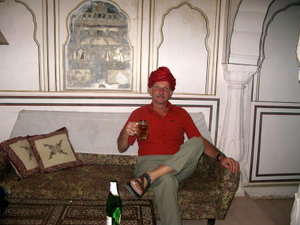Advertisement
Published: March 1st 2009

 The Current Rajah
The Current Rajah
Actually, Tom was given the turban and taught how to "tie" it on his head. 24-26 Feb 2009. The next two weeks will be spent on an Intrepid Trip called “Classic Rajasthan”. This is the Indian state that still has an actual Majarajah, though it’s actually governed just like the rest of the states. The history of the area is different from southern India, as the Mughals invaded about 500 years ago, heavily influencing the culture and religion. (We learned “Mongols” as in Genghis Khan, rather than the word “Mughals”, but they’re the same people.) There are more Muslims than Christians in the mix with the Hindus, along with many Sikhs, who wear turbans and follow a religion that believes in one God only.
In this area, the contrasts between rich and poor are starker. For hundreds of years, the kings have lived in luxurious palaces, frequently fortified to hold off invaders and competing princes, while the common people clustered in small bleak villages around the castle. It reminded me of medieval Europe, except that the level of luxury in the palaces is higher than the primitive castles of Britain and Europe. The palaces are usually now public buildings open to tourists, sometimes with the local lord (the rajah or king) still living in the

 Rush Hour in Jaipur
Rush Hour in Jaipur
Only the tourists pay any attention to the elephants in the traffic.palace.
In Agra, the famous Red Fort is not a military building, though the Indian Army still occupies part of the complex. It’s an extremely luxurious fortified palace built solely for the rajah and his women. The Red Fort was built by three generations of rajahs, with the middle one being Shah Jahan, who built the Taj Mahal for his wife’s mausoleum (more later!), over a period of almost 100 years. It was built with insulated walls of carved marble and red sandstone, “air conditioning”, perfumed fountains, and homes for multiples, concubines, and the king himself. The only other “men” allowed into the complex were eunuchs, who served as guards and servants. This place went on and on, and around each corner was another set of rooms, gardens, fountains, now vacant, but then furnished with carpets, silk curtains, comfortable swings, and lamps. It must have been amazing for European travelers to see.
Also, in Agra is the Taj Mahal, which is probably the most beautiful building in the world. It was built of brick, but is faced with white marble, carved and inlaid with semi-precious stones. It’s huge, and was build solely to contain the remains of Shah

 Fort Madhogarh
Fort Madhogarh
The original noble family still owns this castle and operates it as a small heritage hotel.Jahan’s wife, who died after bearing her FOURTEENTH child for the Shah. No wonder. My favorite: the ceilings, which are carved of marble to look like a rippling silk tent. It’s amazing, and led to our first discussions in the group about the kings’ use of their wealth only for their comfort and pleasure, with little concern for the people who served them.
On 25 Feb, we stayed at Fort Madhogarh, yet another rajah’s fortified palace. It’s way out in the country, and sits on a hill, surrounded by its village. The current rajah still lives there with his wife (his children are in boarding school) - we met him that evening. He’s pretty young and represents the district in the Indian parliament. The place was enchanting, and our bedroom and bathroom were very luxurious - except for the bed, which was metal and really shaky. No hanky panky here!
Next day, we traveled to Jaipur, stopping in Amber to see the Amber Fort, another of the Maharajah’s fortified palaces. This man had the place built for his 12 wives and 300+ concubines. In Jaipur, an interesting city with more markets and shops than I would have believed

 The Taj Mahal
The Taj Mahal
It really is the most beautiful building in the world.to be sustainable, we saw yet more palaces, not all built for the same individual, but all built for the rajahs, local kings and lords and their “bosses”, right up to the maharajah, which translates to “the big king”. He’s the one who still lives here, along with his daughter and her sons, one of whom will someday become the maharajah himself.
Advertisement
Tot: 0.155s; Tpl: 0.011s; cc: 8; qc: 43; dbt: 0.1113s; 1; m:domysql w:travelblog (10.17.0.13); sld: 1;
; mem: 1.1mb

 The Current Rajah
The Current Rajah
 Rush Hour in Jaipur
Rush Hour in Jaipur
 Fort Madhogarh
Fort Madhogarh 
 The Taj Mahal
The Taj Mahal



Paula Jenkins
non-member comment
great commentary...
Sandy: Your commentary is better than a guidebook! Wasn't the owner of Fort Madhogarh dashingly handsome? What did you and Tom think of Delhi? I think I liked Mumbai better.... Back in US...it is so quiet! Lois is in Paris walking in the rain around Marais....lucky dog!